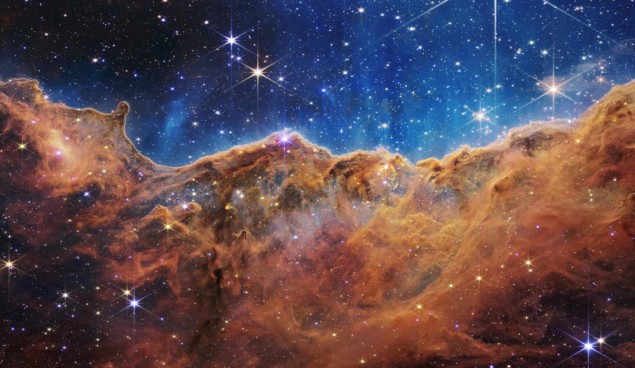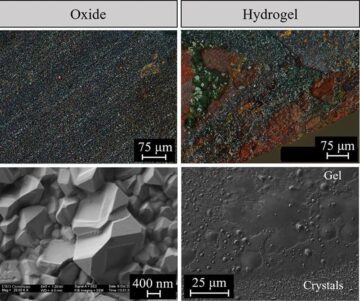A year after its launch, astronomers are revealing the secrets of the universe, as the first scientific results from observations made by the James Webb Space Telescope (JWST) are released. This month, Physics World is publishing a series of blog posts on the discoveries. This is the second post in the series – you can read the first here.

The life and death of stars; setting sights on minor asteroidal and cometary bodies in our solar system; the oldest planets in the universe; and the secrets of supernovae – a rollercoaster ride of new discoveries was revealed on day two of the “First Science Results from JWST” conference, held at the Space Telescope Science Institute in Baltimore, US.
Stellar nurseries on Cosmic Cliffs
One of the first images to be released from the JWST in July this year was that of the “Cosmic Cliffs” – a section of the Carina star-forming nebula located about 8500 light-years away. Previously imaged by the Hubble Space Telescope, the so-called cliffs are made of molecular gas encircling a giant bubble blown in the nebula by the stellar winds and ultraviolet light of five luminous O-type stars, which are the hottest and most massive type of stars to exist. Embedded within the wall of gas are nascent stars. As astronomer Megan Reiter of Rice University explained, the JWST has now identified 24 new outflows from young stars that are still growing by accreting matter from their surroundings. By tracing these outflows, Reiter and her colleagues are able to locate the sites of star formation within the nebula.
The aim of their observations is to better understand what is triggering star formation in the nebula, said Reiter. Do the winds of the five O-type stars compress the gas in the Cosmic Cliffs on the edge of the bubble and trigger star formation that way, or are the knobbly “cliff tops”, where some young stars are forming, simply made from denser regions of gas that have survived the erosional onslaught of the ultraviolet radiation? As of now, more observations are needed, but the JWST is more equipped than Hubble was to answer these question in the future.
Icy building blocks
Young stars are surrounded by proto-planetary discs, where all kinds of complex carbon chemistry can occur, depending on the distance from the star (and hence the temperature), as well as the density of the gas. Yao-Lun Yang of RIKEN in Japan and the University of Virginia, US, showed how the JWST observations of a young protostar catalogued as IRAS 15398-3359 revealed the spectral signature of ices containing complex organic molecules in the disc around the star.
The JWST’s mid-infrared spectrum of the star contains unprecedented detail, showing molecules such as ethanol, methanol, methane and dimethyl embedded within ices in the disc. These molecules are potentially the building blocks for all kinds of carbon chemistry, including life. “The crazy thing to us is that there is so much detail [in the spectrum],” said Yang.
Delayed detonations
Things got explosive with Chris Ashall’s presentation on a type Ia supernova, SN 2021aefx, which exploded in 2021 in the galaxy NGC 1566, located about 33 million light-years away. Type Ia supernovae mainly involve the death of a white dwarf star, but there are several permutations that could give rise to such a supernova – from the destruction of a single white dwarf to a binary merger. There are also questions about whether the explosion detonates in the core of the white dwarf, or whether it is sparked in its outer shell before travelling into the core.
Ashall, of Virginia Tech, talked about how the key to figuring out the dynamics of the SN 2021aefx explosion was in the JWST identifying the location of certain critical ionized elements in the supernova remnant. The JWST was able to detect emissions from doubly ionized cobalt that had decayed from quantities of nickel-56 that had formed in the violence of the supernova explosion. The location of the cobalt, and hence the nickel, was not at the centre of the explosion, but offset from the centre in the outer layers, whereas the JWST did see an abundance of argon at the centre.
There were also spectral lines of nickel-58, which forms in high density regions, suggesting that the white dwarf that exploded had a mass of at least 1.2 times the mass of the Sun – this is nearly as massive as a white dwarf can get (the Chandrasekhar limit of 1.44 solar masses). Comparing the location of the cobalt, argon and nickel lines, Ashall and his colleagues saw that it matched simulations of delayed detonation supernova, wherein a single white dwarf accreting matter from a companion star experiences a wave of intense internal heating that reverberates around the star before it explodes.
Water on the main
Minor bodies in our own solar system were also under the spotlight, particularly the weird objects that astronomers call “main belt comets”. These are objects that behave like icy comets, with tails and comae – but which leisurely orbit around the Sun, in the main asteroid belt between Mars and Jupiter, along with myriad inert rocky asteroids. Their origins and the mechanisms that drive their pseudo-cometary behaviour are still a mystery, one that the JWST has now shed a little light on.
Michael Kelley of the University of Maryland reported on the JWST’s observations of the main belt comet 238P/Read, detecting the spectral signature of outflows of water vapour, but no carbon dioxide, the absence of which is considered unusual. The lack of carbon dioxide is a big clue as to the origin of this particular main belt comet. Either the carbon dioxide was baked out of the comet after it arrived in the asteroid belt, or it never had carbon dioxide in the first place.
“We think it’s more likely that carbon dioxide was never accreted,” said Kelley. This suggests that 238P/Read represents a new class of cometary body that has become trapped in the asteroid belt.
The oldest ones
The solar system formed about 4.5 billion years ago, but the universe is 13.8 billion years old. How soon after the Big Bang could planets form around stars? One place to try and find the answer is globular clusters, which are ancient, having formed 12–13 billion years ago. Matteo Correnti of STScI, spoke about sifting through the stars of one globular cluster known as 47 Tucanae, in search of white dwarfs with anomalous infrared excesses. A white dwarf is the remains of a Sun-like star that has expired, puffing off its outer layers into deep space to leave an inert, hot core. The fluctuating gravitational tides that occur during this slow process of star death can disrupt orbiting planetary systems, smashing them apart and resulting in planetary debris falling onto the surface of the white dwarf. This has actually been observed on younger white dwarfs in the Milky Way, and the planetary debris has a signature in the infrared wavelengths that the JWST observes at.
The stars of 47 Tucanae are calculated to have formed 13.06 billion years ago, so any planets that once existed around one of these stars that became a white dwarf will also be 13.06 billion years old. Correnti revealed that so far they’ve discovered one possible candidate white dwarf with signs of planetary debris. If confirmed, the discovery would be far-reaching, proof that rocky planets could form in the universe less than a billion years after the Big Bang. If there were planets, is it therefore plausible that there could have also been life at this early time?
- Keith Cooper’s next blog post will report on the third day of the conference, covering the JWST’s observations of quasars – some of the brightest objects in the universe – as well as numerous exoplanetary updates.
- SEO Powered Content & PR Distribution. Get Amplified Today.
- Platoblockchain. Web3 Metaverse Intelligence. Knowledge Amplified. Access Here.
- Source: https://physicsworld.com/a/from-the-secrets-of-supernovae-to-the-oldest-planets-in-the-universe-the-first-results-from-the-jwst/
- 1
- 2021
- a
- Able
- About
- abundance
- actually
- After
- All
- Ancient
- and
- answer
- apart
- areas
- around
- Asteroid
- asteroids
- baltimore
- become
- before
- Better
- between
- Big
- Big Bang
- Billion
- Blocks
- Blog
- Blog Posts
- body
- bubble
- Building
- calculated
- call
- camera
- Can Get
- candidate
- carbon
- carbon dioxide
- centre
- certain
- chemistry
- class
- Cluster
- colleagues
- Comets
- comparing
- complex
- Conference
- CONFIRMED
- considered
- contains
- Core
- could
- covering
- critical
- day
- Death
- deep
- Delayed
- Depending
- detail
- DID
- discovered
- discovery
- Disrupt
- distance
- doubly
- drive
- during
- dynamics
- Early
- Edge
- either
- elements
- embedded
- Emissions
- equipped
- ESA
- evening
- Experiences
- explained
- Explodes
- Falling
- far-reaching
- Find
- First
- form
- formation
- formed
- forms
- from
- future
- Galaxy
- GAS
- get
- giant
- GitHub
- Give
- gravitational
- Growing
- having
- Held
- High
- HOT
- hottest
- How
- HTML
- HTTPS
- Hubble
- Hubble Space Telescope
- ia
- identified
- identifying
- image
- in
- Including
- information
- Institute
- internal
- involve
- issue
- IT
- James Webb Space Telescope
- Japan
- July
- Jupiter
- Kelley
- Key
- known
- Lack
- launch
- Leave
- Life
- light
- likely
- LIMIT
- lines
- little
- located
- location
- LOOKS
- made
- Main
- mars
- Maryland
- Mass
- masses
- massive
- Matter
- max-width
- Merger
- methane
- Methanol
- Milky way
- million
- minor
- molecular
- Month
- more
- most
- Mystery
- Nasa
- nascent
- nearly
- Nebula
- needed
- New
- next
- Nickel
- numerous
- objects
- obscured
- Observes
- offset
- Old
- oldest
- ONE
- Orbit
- orbiting
- organic
- Origin
- outflows
- own
- particular
- particularly
- Place
- Planets
- plato
- Plato Data Intelligence
- PlatoData
- plausible
- possible
- Post
- Posts
- potentially
- presentation
- previously
- process
- proof
- Publishing
- question
- Questions
- Radiation
- Read
- region
- regions
- released
- remains
- report
- Reported
- represents
- resulting
- Results
- Revealed
- Reveals
- Rice
- Ride
- RIKEN
- Rise
- rocky
- Said
- Science
- Search
- Second
- Section
- Series
- setting
- several
- Shell
- Sights
- Signs
- simply
- single
- Sites
- slow
- So
- so Far
- solar
- Solar system
- some
- Soon
- Space
- space telescope
- Spectral
- Spectrum
- Spotlight
- Star
- Star formation
- Stars
- Stellar
- Still
- such
- Suggests
- Sun
- supernova
- Surface
- surrounded
- Survived
- system
- Systems
- tech
- telescope
- The
- The Future
- their
- therefore
- thing
- Third
- this year
- Through
- thumbnail
- time
- times
- to
- Tracing
- trigger
- triggering
- true
- under
- understand
- Universe
- university
- University of Maryland
- unprecedented
- Updates
- us
- virginia
- Water
- Wave
- wavelengths
- What
- What is
- whether
- which
- white
- will
- winds
- within
- would
- year
- years
- young
- Younger
- zephyrnet













